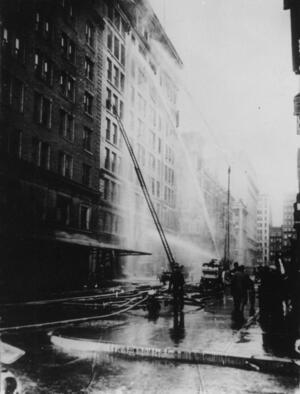Tragedy in Bangladesh
A few years ago I brought a friend to see a performance of music and photos dedicated to the Triangle Shirtwaist Factory fire at the Boston Jewish Music Festival. I had done my research beforehand, and knew of the horrible fire and unsafe working conditions that claimed the lives of 146 young workers- many of which were young Jewish and Italian immigrant women. My friend, however, followed me blindly to the performance. I watched his face fall as he discovered the show was not a whimsical orchestra of musicians all playing the triangle, but a heartbreaking and poignant look at how child labor and sweatshops endangered many young women in our country.
Although the Triangle Shirtwaist Factory fire took place in 1911, sweatshops and unsafe conditions are not a thing of the past. Just yesterday over 600 workers were injured and 70 were killed in the collapse of a garment factory in Bangladesh. According to reports, cracks appeared in the walls earlier this week and labors were ordered to toil on in unsafe conditions. Tragically this collapse comes only a few months after a fire killed over 100 workers in another garment factory in Bangladesh.
There is a long tradition of Jewish involvement on both sides of the labor struggle—especially in the American garment industry. While Jewish union workers and organizers like Rose Schneiderman and Clara Lemlich fought at the front of the battle for safer labor practices, other Jews like Isaac Harris and Max Blank, owners of the Triangle Factory, exploited laborers and caused much suffering.
Current labor-related disasters such as the factory collapse in Bangladesh give us the opportunity to reflect on our place in this ongoing struggle, as humans and as Jews. In contemporary labor issues, Jews often fill the roles of consumers, allies, owners, and indeed exploiters, rather than as laborers themselves. Our newest education project, Living the Legacy, chronicles the complex and dynamic relationship between Jews, Jewish tradition, and the Labor Movement. The sources and background essays within it were developed specifically to encourage readers and participants to examine this issue more closely.
Lesson one, Bread and Roses, defines basic needs and explores ideas about work, dignity, need, and responsibility through music, memoir, photographs, and traditional Jewish texts. Lesson two, From Suffering to Action, From the Individual to the Collective, investigates the motivations of immigrant women that led to the strike known as the “Uprising of the 20,000” in 1909-1910, and the ensuing tragedy of the Triangle fire that led to lasting labor reform. Lesson four, Workers and Their Allies, Then and Now, explores the myriad ways Jews have organized to support workers and their families and outlines the changing role of the Jewish community in providing aid and support for laborers. Finally, lesson 8, Contemporary Jewish Labor Campaigns: The Labor Movement Begins at Home, explores contemporary Jewish labor campaigns on issues such as the living wage and the Domestic Workers’ Bill of Rights and analyzes how and why Jewish organizations are advocating in solidarity with oppressed workers.
Tragedies like what happened in Bangladesh are without a silver lining. However, these stories remind us that we—as laborers, consumers, allies, and Jews—have a traditional and historical legacy to uphold in the struggle for the rights and safety of the workers on whom we rely.








Ellen, thank you so much for your comment and sorry for our delayed response. Unfortunately this question is sill quite pertinent.
After some searching, there doesnÌ¢âÂã¢t seem to be an overwhelming movement within the American Jewish community to address these labor issues in Bangladesh, despite our connection to previous workplace disasters (i.e. the Triangle fire). Perhaps Jews are choosing to take action on different issues, or to take action against labor injustice through non-Jewish campaigns and organizations? Maybe most of us have moved too far away from the experience of laborers to feel motivated to take action?
Here are a few resources that begin to answer your question:
This article from The Jewish Daily Forward dated May 31, 2013 (http://forward.com/articles/17..., highlights the different key players in contemporary labor issues and discusses how globalization complicates the successful solutions of the Ì¢âÂÒsimpler daysÌ¢âÂå of the Triangle. Given that Jews are more often consumers or employers of labor, rather than laborers ourselves, how can we as a community begin to make change within the system described here? (Also not a rhetorical question.) Is there a place for us as Ì¢âÂÒthe Jewish Community?Ì¢âÂå If so, what is it? If not, where is our place?
The Jewish Labor Committee (http://www.jewishlaborcommitte... is currently running a petition to the management of Walmart (http://act.aflcio.org/c/949/p/... to join an international accord (known popularly as the PVH-Tchibo plan [http://www.nytimes.com/2013/05...]) which includes a binding, independent inspection program, mandatory improvements in workplace safety, and binding arbitration enforceable in the courts of the country where a company is based, rather than an unenforceable self-audit of factory conditions. (Wal-Mart is currently one of several North American corporations spearheading the Alliance for Bangladesh Worker Safety (http://www.bangladeshworkersaf..., the actions proposed by which have received much criticism [http://world.time.com/2013/07/...] from labor advocates and unions.)
In addition, the Jewish Alliance for Law and Social Action (JALSA) (http://jalsa.org/en/) responded by posting corporate addresses for companies that buy from Bangladeshi factories (http://www.jalsa.org/en/?p=621... and asking people to write to CEOs and pressure them to change their policies.
Several educators within our network have been sharing this story with young people, raising awareness about the issue, and having students discuss it from a consumer standpoint. Our Go & Learn activity guide about labor activism and communal responsibility (http://jwa.org/teach/golearn/s... has a print-ready lesson plan for youth (teens) that presents one way of introducing ideas of collective responsibility, action, and consumer activism to students.
Please let us know if you have heard of other actions for labor reform in Bangladesh that are taking place within (or outside of) the Jewish community. We would love to help spread the word. Thanks also for having the courage to take our community to task on this issueÌ¢âÂÛit seems there should be more practical conversation and action on this front.
Internet search on Jewish response to Bangladesh building collapse yielded essentially nothing. Appreciate this JWA posting but is anyone doing anything besides nostalgically evoking Triangle? This is not a rhetorical question; would appreciate any information about action in this area.